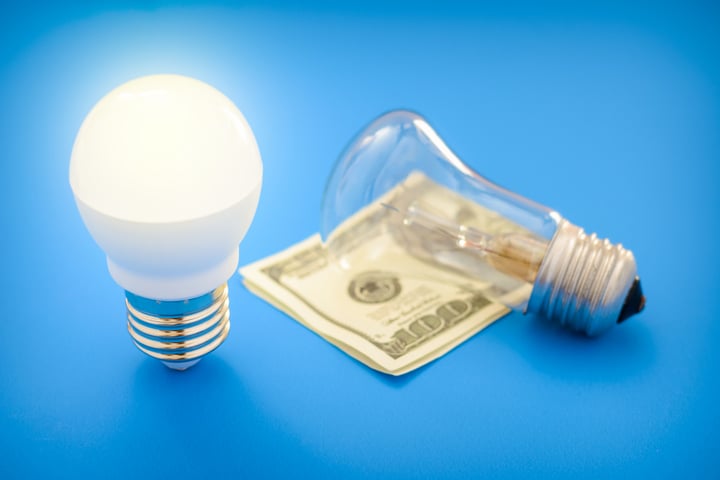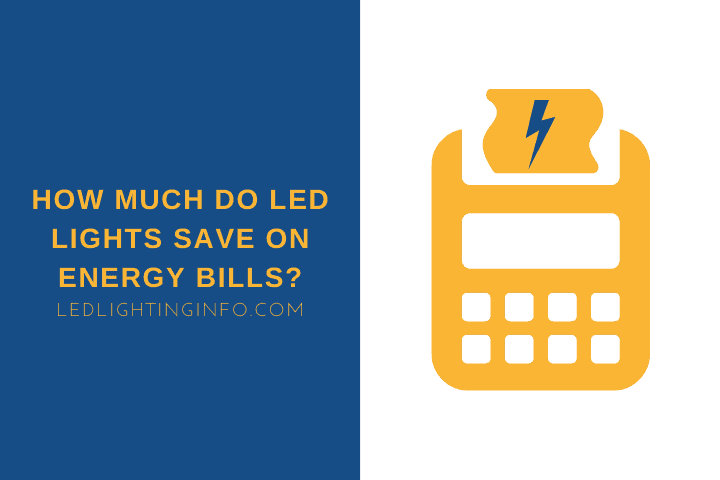If you want to save hundreds of dollars every year, then keep reading.
I’m going to share with you how much you’re going to save in energy bill just by swapping all the lights in your home for LED bulbs.
We’re going to get into the specifics and try to dial in on how many hundred dollar bills will stay in your wallet just by making the switch.
You’re able to save up to $600 a year just by switching all the lights in your home. The upfront cost will be covered in less than half a year. Incandescents require replacement every 3-4 months, which is inefficient and costly. LED bulbs will last you for years and cost fraction to run.
In this guide, you’ll learn about:
- The upfront cost of LED vs incandescent, and why it can be misleading
- The energy consumption of LED bulbs
- The savings you earn in a month and a year with handy calculator
- Additional considerations to account when calculating savings
Sounds good?
Let’s start at the beginning investment you have to make…
LED Light Bulbs Upfront Cost Comparison

You already know that it costs more than an incandescent bulb. Walk down the lighting aisle in a shopping store, and you’ll see a big difference between incandescent and LED technology.
Because of its growing technology, the price of LED lights is continually dropping, but there’s still a big difference compared to incandescent light bulbs.
But, to really compare the two, you need to get them on an even playing field.
You see, a typical 60-watt incandescent bulb costs only $1.00. A 10-watt LED bulb that produces the equivalent amount of lighting to the incandescent bulb will cost you around $6, if you pay for a quality one.
But now you have to factor in the lifespan of the bulbs. Incandescent bulbs have a lifespan of 1,200 hours.
LED light bulbs, on the other hand, will last you for 20,000 hours with some reported to last up to 50,000 hours. You’d have to buy 16.6 incandescent bulbs to last as long as one LED bulb!
So, at the end of the day, you’re spending around $16 for incandescent bulbs as opposed to $6 for LED lights.
And to give you a clearer picture:
If you turn on your lights at, say, 8 pm till 5 am, that’s 9 hours a day. An LED with a 20,000-hour lifespan will be operational for 2,222 days, or around 6 years.
An incandescent bulb, on the other hand, has to be replaced every 4 months!
Okay, I’m sure you’re saying to yourself, nothing works perfectly. Everything breaks, so what makes you sure LED bulbs will last for 6 years?
You’re right there.
But I’m sure you’ll agree that even if it lasts for only for 3-5 years, you’re still saving a lot of money!
In short, let’s put the upfront bulb cost side-by-side for 20,000 hours of service:
- LED bulbs: $6
- Incandescent bulbs: $16
Incandescent Vs LED Bulbs Energy Costs

Next, we’ll cover the cost of running these light bulbs.
To find out the energy consumption of a bulb, you’ll have to use the formula wattage of lamp converted to kilowatts, multiplied by hours used.
This gives you Kilowatt Hour (KWh).
KWh is how your utility company measures your usage, and they charge you a certain amount per kilowatt-hour. So we have…
Total Energy Cost = average energy price(c/KWh) * KWh
The average energy cost is dependent on where you live and can vary quite a bit. Here are a few examples from different countries to give you a clear picture:
- Idaho, US: USD 0.08/KWh
- New York, US: USD 0.18/KWh
- London, UK: GBP 0.14/KWh (equiv. to USD 0.18)
- Singapore: SGD 0.24/KWh (equiv. to USD 0.18)
- Solomon Islands: USD 0.99/KWh
A search online or a quick look at your utility bill will tell you how much they’re charging you for one KWh. Once you know the numbers, we can start measuring the cost of running our bulbs.
Let’s start with Thomas Edison’s baby, the incandescent light bulb. Let’s use Idaho for our example. Let’s also assume the lights are switched on for 9 hours a day, 7 days a week.
60W = 0.06KW
Total Energy Cost = USD 0.08 * 0.06KW * hours
| Monthly (9 hours for 30 days, 270 hours) | Yearly (9 hours for 365 days, 3285 hours) | 9 hours for 6 years (20,000 hours) |
|---|---|---|
| $1.296 | $15.768 | $96 |
Great.
Now let’s do that for the LED. We’ll use the same location and the same amount of usage time. Let’s assume LED use 10W.
In reality, you can often get the same light output with 8W LED light bulb, which will be even more energy efficient.
10W = 0.01KW
| Monthly (9 hours for 30 days, 270 hours) | Yearly (9 hours for 365 days, 3285 hours) | 9 hours for 6 years (20,000 hours) |
|---|---|---|
| $0.216 | $2.628 | $ 16 |
Total yearly savings per light bulb = $15.77 – $2.63 = $ 13.14
As you can see LED technology is extremely energy efficient and those numbers are clear as day. But, there are a few more things for you to consider.
How Much Does Changing To LED Lights Save? Interactive Calculator

Am I really saving just a dollar a month by swapping to LED?!
Of course not. The numbers above are only for one bulb. The average US household has more than 40 sockets for light bulbs [source].
If we multiply the numbers by 40, we’ll get…
Incandescent Bulb Monthly Cost = $51.84
LED Bulb Monthly Cost = $8.64
Total savings per month = $43.20
$40 can get you 5 large Domino’s Pizza. You can subscribe to Netflix as a Premium user for 2 months at $40. That’s money you can spend on your hobbies, home improvement, or a dinner date.
And, if you set aside the money, not touching it for a year, you’ll have roughly $526. That’s enough extra cash to buy a few of the luxuries in life to enjoy them.
There’s no extra work to be done. All you have to do is replace dated bulbs with more energy efficient technology, and you’ll start saving money.
I know, it is nice to have such a detailed explanation, but all the calculations can get confusing.
So with that in mind, I have created the calculator that estimates the savings you will make by merely swapping old incandescent bulbs in all your lighting fixtures in your house.
It uses exactly same logic, as I have explained earlier.
The good thing is that it works for your specific situation.
Input your electricity rate, average usage of lights and how many lights you want to swap and in a second you will know how much money you can expect to save with LED light bulbs.
You can actually calculate savings of swapping fluorescent lights with LED bulbs as well. Simply change the field “Old Bulb Wattage” to the wattage of your CFL bulbs.
Because fluorescent bulbs are much more energy efficient compared to incandescents, the total energy savings will not look as impressive.
Read my other article about viability of replacing CFL light bulbs with LED.
Additional Considerations
The calculation above is a great estimate of energy savings, however it is a simplified version. It didn’t factor additional costs of replacing incandescent bulbs every 4 months.
It also doesn’t tell you when the upfront cost is covered and you start making savings from switching to LED.
So let’s take everything into account…
Incandescent
Yearly Electricity Cost = $630.72
A bulb has to be replaced 2.63 times each year.
Cost of replacements each year = $105.2
Total Cost = Yearly Electricity Cost + Cost of Replacements = $735.92
An LED setup will cost you only $105.12 yearly.
That’s more than $600 that you get to keep in your wallet. Sure, it might cost you $240 to buy 40 LED bulbs initially.
But you’ll break even in just after 5 months!
Everything saved afterward is a return of your investments.
Throughout the 20,000 hours lifespan of an LED bulb, you’ll save a total of $3,640!
Imagine what you can do with that kind of money.
You’ll be able to treat yourself to a long-overdue holiday, or pay off your credit card debt, or set it aside and let compound interest do its work.
Last but certainly not least think about all the waste that will not be released into landfill from power plants as a result of smaller energy consumption.
Final Words
This guide covers everything you need to know about the financial aspect of converting to an energy efficient LED lighted home.
I’m sure you see the transition will only bring positives to your life. You’re not just fighting global warming by reducing the carbon footprint and the energy wastage of your home.
You’re also holding on to your hard-earned cash so that you can treat yourself or your family with it.
Start calculating now how many hundred dollar bills will stay in your wallet just by taking this decision. Do the calculations above.
- Are you saving more than the example I’ve given?
- Do you have an idea of what you’re going to spend the saved money on?
Let me know in the comments below.
Looking for an LED bulb but not sure what type you need?
Check out my free bulb picker and select the right bulb within few clicks.

